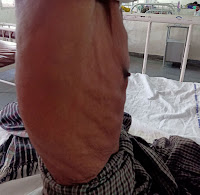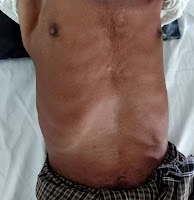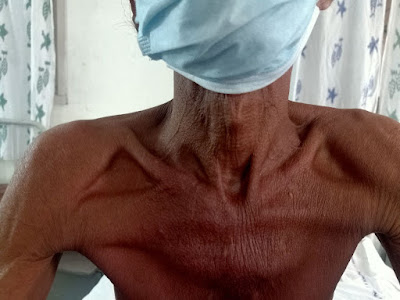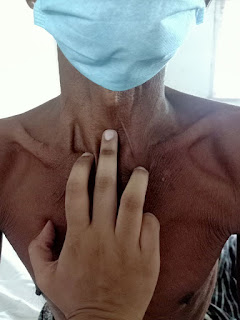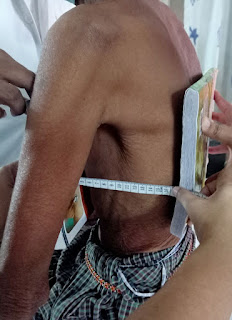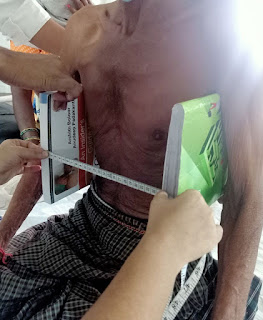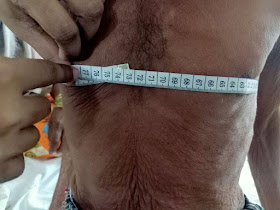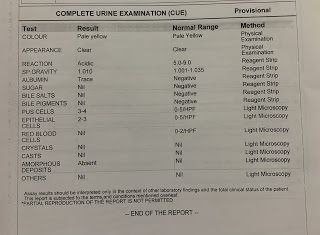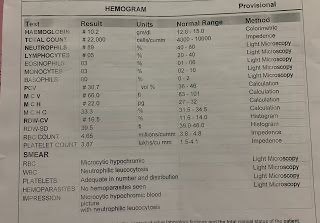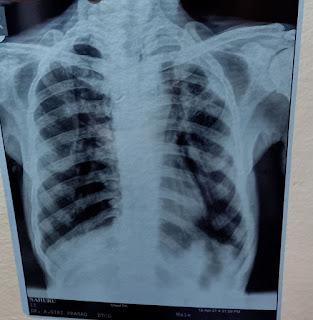JULY ASSESSMENT
Question 1
Case-1
1.case : https://amishajaiswal03eloggm.blogspot.com/
question : 1) What is the evolution of the symptomatology in this patient in terms of an event timeline and where is the anatomical localization for the problem and what is the primary etiology of the patient's problem?
Review:I agree with the diagnosis because the patient works in paddy fields so he is affected with the allergens in the paddy field .The flow chart answered in this question is appropriate and gives the complete symptomatology .
My review-
This is a case of a patient with cervical Myelopathy.patient came to hospital with complaints of weakness of all 4 limbs preceeding alcohol binge and fall.
In the answers
Condition of Myelopathy hand is defined clearly and pyramidal tracts are also mentioned.. It would be better if used a picture of this condition. Finger escape condition is explained and the nerves and muscles involved are also explained. And how finger escape is seen in cervical Myelopathy is also explained. Hoff mans reflex is also explained.. The explanation part is good.. But if diagrams are inserted it would be much more easier for understanding.
2 .case : https://avulanikhil09.blogspot.com/
Question: could chronic alcohlism have aggravated the foot ulcer formation ?if yes and why ?
Review : the answer for this explained is true and due chronic alcoholism ➡️ diminished immune response ➡️leads to ulcers
My review-
informative and easy to comprehend to the point answers and very brief ,the usage of flow charts and diagrams is well used the usage of text can be better and the overall elog was well written.
3. case: https://bejugamomnivasguptha.blogspot.com/
Question : Is there any relationship between occurrence of seizure to brain stroke. (3 m)
Review : it is obviously true that shock may lead to seizures .
Shock ➡️scar formation in brain ➡️it disrupt electrical signal ➡️it leads to seizures .so the explanation in this answer is exactly true
My review-
Patient came to opd with chief complaints of palpitations, pedal oedema, chest heaviness, radiating pain along the left upper limb. Patient was diagnosed with cervical spondylosis and recurrent hypokalemic paralysis.
About the answers given..anatomical localisation is mentioned and primary etiology is discussed deeply.. And causes of the symptoms are explained and possibility of other diseases are mentioned. Tables are used to explain clearly.. Risk factors of hypokalemia are mentioned and ecg changes in hypokalemia are explained with diagram. Usage of tables and diagrams made this presentation a bit more effective.
4.case :https://daddalavineeshachowdary.blogspot.com/
Diagnosis : it is a case of 55 yr old female with viral pneumonia secondary to covid 19 and Dm
Review : The case discussion is very good and the treatment is explained in the right order .
My review-
This is a case of acute coronary syndrome. The patient came to OPD with shortness of breath . She is known case of HTN and DM. The review is very well written in the form of nice flow chart about her past illness to present illness. And risk factors of DM and HTN point to a cardiac origin is also explained. In the review indications and contradictions of PCI is very well explained. The patient is treated for all her symptoms.
Ioi
5.Case :https://budigesaikiran14.blogspot.com/
Diagnosis : alcohol induced cerebellar ataxia
Review : Reasons for cerebellar ataxia is very well discussed .
It is due to damage to GABA -A receptor impaired glucose metabolism vit B1 deficiency .the way of answering a question is so attractive and it is easy to understand .
My review-
The symptomatology has been explained in a chronological order of occurrence.
The primary etiology of the patient has been mentioned with the necessary finding along with the pictorial representation.
The anatomical location of the problem has been described.
The mechanism of action was very well explained with the action of the pharmacological drugs administered.
The answers for the given questions were commendable along with the usage of statistics
6.case: https://aniganikavya06.blogspot.com/
Diagnosis :Acute exacerbation of COPD associated with right heart failure and bronchiectasis.
Review : What is the evolution of the symptomatology in this patient in terms of an event timeline and where is the anatomical localization for the problem and what is the primary etiology of the patient's problem?
Anatomical Location of problem-Lungs- Bronchi and bronchioles
Primary etiology- Usage of chulha since 20years
Answer explained is appreciable .every thing is really so point to point and easily understandable
My review-In this answer the etiology of the patient's problem is COPD due to conseqeunce of using chulha but I think that the problem is also with allergy while she is working in the paddy fields. The patient is suffering from the shortness of breathing from long time due to the inhalation of smoke and that caused damage to the lungs,thus the patient is susceptable to the lung infections.
In this link, the evaluation of symptomatology was explained well. Pharmacological and Non pharmacological interventions were mentioned but not in a detailed manner. The placebo effect was also not explained properly. I think the overall case and the answers to the questions could have been explained properly.
Case : 7 https://02shishirareddy.blogspot.com/
Diagnosis : Alcohol induced dementia
Review : Causes for electrolyte imbalance:
Respiratory acidosis with metabolic alkalosis(due to renal compensation) in AECOPD patientswith chronic hypercapnia is the usual cause ofhypochloremia in these patient Commoncauses ofderanged serum sodium levels include hyperglycemia, use of thiazides or nonsteroidal anti-inflammatory drugs, congestive cardiac failure, chronic renal failure, and low dietary salt intake.
Common causes of hypokalemia include diarrhea, laxative abuse, vomiting, certain diuretics, drugs like insulin, β2agonists, and theophylline.20 Thus, COPD patients per
se are predisposed to electrolyte imbalance. In turn electrolyte imbalance can cause respiratory muscle weakness, cardiac arrhythmia, low cardiac output.
Thus the presence of electrolyte imbalance leads to significantly poor outcome among COPD patients.It is very interesting to know about the acidosis and very happy to read and get the knowledge about respiratory acidosis .it is really very helpful .
My review-
The history of present and past illness is coherent and well established. The videos are great for understanding the case. The case sheet has captured all the relevant data in the right order. Correct terminology was used. The reports of all the lab investigations conducted were given. The pharmacological intervention was elaborate and explained well.
The symptomatology with anatomical localization and primary etiology was explained very well. The explanation was done with help of diagrams which made it easier to understand. The treatment part was also explained with all the drugs and injections that were given to the patient. The causes that are explained for acute exacerbation and for electrolyte imbalance were appropriate. At last all the questions were answered and case was handled well.
Case :8 https//savanthreddy.blogspot.com/
Diagnosis : INFECTIOUS DISEASE (Mucormycosis)
Review : What are the postulated reasons for a sudden apparent rise in the incidence of mucormycosis in India at this point of time?
I think it is because of the use steroids in an uncontrolled manner.
COVID 19 is not the first disease where steroids are used as one of the main stay of treatment (in severe cases) but what has gone wrong in the recent time is even the lay man who got infected with Corona started using steroids right from the day 1 with no monitoring by a specialised physician.And they are not following any specific course of treatment.As many of them are also diabetic patients the are getting succumbed to mucormycosis.And it is not ending with mucormycosis but various other fungii are emerging to cause an epidemic.
And another reason for rise in mucormycosis cases may be the usage of tap water in oxygen concentrators.As most of the patients are being diagnosed of Covid in late stages in the second wave many of them Are requiring oxygen concentrators for supplemental oxygenation.And due to Lack of the people are using tap water instead of distilled water which serves as reservoir for the growth of mucormycosis.So this may be one of the reason for rise in mucormycosis cases. I feel really happy by reading this new information about the disease that is happening in our india and it is very well explained with the good image and reason behind the this epidemic
My review-
Evolution of symptomatology was listed in a chronological order which was easy to understand. Only non-pharmacological interventions were explained, could have been better if pharmacological interventions were also included. The cause for acute exacerbation in this case was not explained in detail. Overall, the answers to the questions could have been answered in a better way by adding some of the elements as mentioned above and explaining them in detail.
Case 9 : https://gsuhithagnaneswar.blogspot.com/?m=1
Diagnosis : cervical spondylosis Recurrent hypokalemic paralysis
Review : What are the reasons for recurrence of hypokalemia in her? Important risk factors for her hypokalemia? ➡️Since the patient complains of oedema the drugs used to relieve it such as diuretics can cause hypokalemia
The patient also no albumin which is a cause for both oedema and hypokalemia
The risk factors including
1. Alcohol use(excessive
2. Chronic kidney disease
3. Diabetic ketoacidosis
4. Diuretics (water retention reliever
5. Excessive laxative
6. Folic acid deficiency
7. Primary aldosteronism
8. Some antibiotic uses
It is point to point and easy everything is easily reviseble .happy to read about this new case
My review-
The evolution of symptoms was explained in tabular form chronologically,it is quite good.Pharmacological and non-pharmacological interventions of each drug are explained with their mechanisms.But there are no pictures and flow charts.The journal link was also updated for more info.
Case 10 : https://blendedasessmentmadhukumar.blogspot.com/
Diagnosis : inferior wall MI with uncontrolled sugars with k/c/o DM since 8yrs.
Review : What is the evolution of the symptomatology in this patient in terms of an event timeline and where is the anatomical localization for the problem and what is the primary etiology of the patient's problem?
➡️Chest pain- since 3days
Giddiness - since morning
Profuse sweating- since morning
Anatomical location of the lesion is inferior wall of the heart.
Etiology:
Smoking
Diabetes mellitus
Hypertension
My review-
The symptomatology in the patient in terms of an event, based on timeline was explained properly. The pharmacological and Non-pharmacological interventions used by this patient were appropriate and in detail. All the questions were also answered but could have been listed the causes properly.
Q2-4
Patient centered data around the theme of renal failure patients with AKI, CKD and acute on CKD,
captured by students from 2016 and 2019 batch in the links below
Patients with low back ache and renal failure
Q2) Share the link to your own case report of a patient that you connected with and engaged while capturing his her sequential life events before and after the illness and clinical and investigational images along with your discussion of that case.
http://arunrollno46.blogspot.com/2021/07/aki.html
I have helped my juniors in taking histories and guided them in preparing elogs and presenting them in groups and in 2-4 sessions.
Q3) (Testing peer review competency of the examinees) :
Please go through the cases in the links shared above and provide your critical appraisal of the captured data in terms of completeness, correctness and ability to provide useful leads to analyze the diagnostic and therapeutic uncertainties around the cases shared.
AKI
https://laharikantoju.blogspot.com/2021/07/58-year-old-male-patient-elog-lahari.html?m=1
Over view
A 58 year old male patient came to casualty with chief complaints of:
- lower abdominal pain: 1 week
-burning micturation:1week
- low back ache after lifting weights
-dribbling / decrease of urine out put:1week
-fever :1 week
- SOB , rest :1week
Apprisal
Case history was taken well and examination was very well done... Sequential evaluation of case is apprisiable
Negative points
It would be better if fever chart is added as it was treated with strict temp and IO monitoring as it would be better understood improvement of the case was not well mentioned
My Analysis
This is a case of Acute kidney injury( AKI) 2° to UTI, associated with Denovo - DM -2
With ? Right HEART FAILURE,
With K/C/O - HTN ( Not on Rx)
-AKI causes a build-up of waste products in your blood and makes it hard for your kidneys to keep the right balance of fluid in your bodyand return of creatinine to the base line and symptoms less then 3 months indicating it to be a AKI
Acute on CKD :
http://srinaini25.blogspot.com/2021/07/srinaini-roll-no-33-3rd-semester-this.html
Over view
A 75yr old male patient ,labourer by occupation ,came to casuality with Cheif complaints of
• Lower backache since 10days
• dribbling of urine since 10days
• Pedal edema since 3days
• SOB at rest since 3days
• Increased involuntary movements of both upper limbs since 10days .
Apprisal
I would not find any points to be highlighted . History was taken well
Negative points
There are no clinical pics of the symptoms like pedal edema.
Proper chronological order of symptoms apperance was not done
Fever chart was not included.
No IO charting was done though it was told it should be strictly monitored
My Analysis
This is case of
Acute renal failure (intrinsic)
Grade 1 L4-L5 Spondylodiscitis, Multifocal infectious Spondylodiscitis
Hyperuricemia 2° to Renal failure
Uraemia induced tremors( resolved)
Delerium 2° to septic /Uremic encephalopathy (resolving)
CKD :
https://krupalatha54.blogspot.com/2021/07/a-49-yr-old-female-with-generalized.html?m=1
Over view
A 49 yr old female , mother of 2 children, who is a house wife, apparently asymptomatic 13 yrs ago and then she noticed mass per anum with bleeding , went to hospital and diagnosed as haemorrhoids and got operated.
- Since 3 yrs she has history of muscle aches, for which she is using NSAIDs.
- She has h/o fever 20 days back, got treated in the local hospital, and
- Since 20 days she has generalized weakness.
- She also has h/o vomitings since 3 days, with food as content, non - projectile , non bilious.
Apprisal
History was taken well.
Good lab work clear evaluation was done
Negative points
There are no clinical pics of the symptoms like pedal edema.
Proper chronological order of symptoms apperance was not done
Fever chart was not included.
No IO charting was done though it was told it should be strictly monitoredit would have been better if urine was sent for eosinophils for interatial disease
My Analysis
This is case of CKD ?
Chronic interstitial nephritis secondary to plasma cell dyscariasis, (multiple myeloma - 70% plasmacytosis).
Patient with coma and renal failure
https://ananyapulikandala106.blogspot.com/2021/06/a-35yr-old-female-elog.html
Overview
A 35 yr old female with Fever and Diarrhea since 5 days( 4 to 5 times a day with blood discharge).
Back pain( 5 days ago) with abdominal pain and chest pain.
Apprisal
Very well presented
With good fever charting with all the necessary information.
History was taken detailed way
Follow up was good
All the tests were properly done
Negative
I could not find the negative data in the elog
My analysis
It could be the hypoxia which could have caused the permanent brain damage which was the reason for her vegetative state . Subjectively she was told better but objectively no improvement was Seen. Hospitalisation has increased the infection to the bed sore it would have been better if discharged early as it was permanent damage and was impossible to treat anyway.
Q4: Testing scholarship competency of the examinees ( ability to read comprehend, analyze, reflect upon and discuss captured patient centered data as in their 'original' answers to the assignment for May 2021):
Please analyze the above linked patient data by first preparing a problem list for each patient (based on the shared data) and then discuss the diagnostic and therapeutic uncertainty around solving those problems. Also include the review of literature around sensitivity and specificity of the diagnostic interventions mentioned and same around efficacy of the therapeutic interventions mentioned for each patient.
Analysis the data
https://ananyapulikandala106.blogspot.com/2021/06/a-35yr-old-female-elog.html
Analysis of A 35 yr old female with Fever and Diarrhea since 5 days( 4 to 5 times a day with blood discharge).
Back pain( 5 days ago) with abdominal pain and chest pain
Vegetative state of the patient could be due to hypoxia which could have caused the permanent brain damage which was the reason for her vegetative state . Subjectively she was told better but objectively no improvement was Seen.
https://pubmed.ncbi.nlm.nih.gov/19362767/
Link supporting the data
Intermittent Fever spikes can be explained due to the bed sores clearly explained through culture of the sores
Sepsis might be the reason for encephalopathy by altering the blood brain barrier
https://www.hindawi.com/journals/amed/2014/762320/
Q 5) Testing scholarship competency in
logging reflective observations on your concrete experiences of this last month : (10 marks)
Reflective logging of one's own experiences is a vital tool toward competency development in medical education and research.
The telemedical learning from the hospital has been a new experience and we learnt quite lot of things through reflective observation during lockdown. it's a bit challenging as we have just entered internship ,We have learnt elogging of the cases in a very short span of time and made juniors do so. I could answer the questions from juniors easily as I have been part of many discussion in ICU and wards . By doing this assignment I could view many cases and many case scenarios through which I learned many things






























